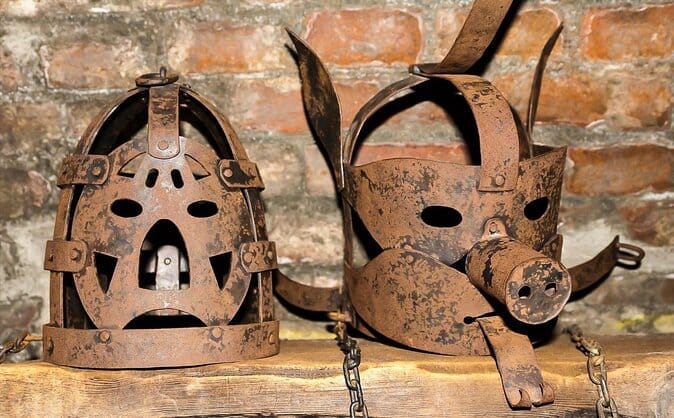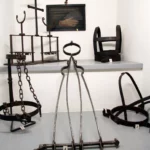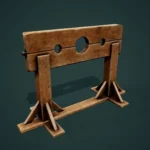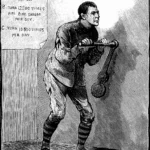Step into the shadows of history, where torture devices lurked in the depths of medieval dungeons. Like macabre works of art, these instruments of pain were designed with precision, each one a testament to the twisted ingenuity of those who wielded them. Join us as we embark on a chilling journey through the gruesome world of medieval torture, uncovering the secrets and horrors that lie within.
Medieval Devices of Excruciating Torment
In the dark ages of medieval times, torture devices were synonymous with inflicting unimaginable pain and suffering. These cruel contraptions were meticulously crafted to inflict maximum agony upon their victims.
Unveiling the Sinister Arsenal
The medieval torture arsenal featured a chilling array of devices designed to inflict specific horrors:
- Iron Maiden: Picture a coffin adorned with razor-sharp spikes that mercilessly crushed its victims.
- Rack: This gruesome stretcher delivered unimaginable pain by stretching limbs to their grotesque limits, tearing muscles apart.
- Thumbscrews: A device that relentlessly crushed thumbs between unforgiving metal plates.
- Chair of Agony: This spiked seat served as a throne of misery, piercing the flesh of those who dared to sit upon it.
- Brazen Bull: A grotesque metal bull heated from below, roasting victims alive within its hollow belly.
The Barbaric Purposes of Torture
These devices were wielded for sinister purposes:
- Confession Extraction: Torturers sought to wrest confessions from the lips of the innocent and the guilty alike.
- Punishment and Execution: Those who defied authority or committed heinous crimes faced the wrath of medieval justice, often ending in execution or relentless agony.
- Population Control: Torture served as a chilling reminder of the consequences of dissent or resistance.
- Medical Experiments: While infrequent, torture was occasionally used to conduct macabre medical experiments on unsuspecting victims.
A Gruesome Slice of History
In the medieval era, torture was an accepted part of the legal system and social order. Trained executioners carried out these atrocities, and the victims endured unspeakable suffering with little hope of justice. However, as society evolved, the use of torture devices dwindled, replaced by growing revulsion and ethical concerns.
Moral and Legal Condemnation
Today, torture is universally condemned as a cruel and ineffective practice. International law strictly prohibits it, recognizing the fundamental rights of victims to seek redress and compensation for the heinous crimes committed against them.
Ever wondered what were the medieval torture devices used in the medieval period? Or what were the torture devices medieval times actually looked like? Our page has got you covered.
But if you are faint of heart, then you might want to skip our page about the worst torture methods in history. However, if you are curious about the stretching torture device or medieval torture in general, then click away!
How Did Torture Devices Evolve Over Time?
Torture devices have been with us for centuries, and over time, they’ve gotten way more gruesome. From simple whips to terrifying contraptions, the goal has always been the same: to cause extreme pain and suffering.
Ancient Roots
In ancient times, torture devices were pretty basic. People used things like whips, stocks, and branding irons to punish criminals and prisoners. But as societies became more complex, so did the tools of torture.
Medieval Mayhem
The Middle Ages was a particularly nasty time for torture. The rack, where people were stretched until their bones cracked, was a popular choice. And the brazen bull, a hollow bronze statue that was heated from below, was so horrible that just hearing about it could make you scream.
Enlightenment Era
Finally, during the Enlightenment, people started to realize that torture wasn’t cool anymore. The use of these devices declined, and eventually they were banned in most civilized countries.
Modern Day
Today, torture is still used in some places, but it’s not something that anyone can just do. It’s illegal under international law, and anyone caught doing it can face serious consequences.
Torture Device Timeline
| Period | Devices |
|---|---|
| Ancient | Whips, stocks, branding irons |
| Medieval | Rack, impalement sticks, iron maiden |
| Modern | Banned in most civilized countries |
It’s hard to imagine why anyone would ever want to use these devices, but the truth is, they were once considered necessary for maintaining order and punishing criminals. Today, we know better. Torture is never justified, and it’s a violation of basic human rights.
What are the psychological effects of torture?
Torture is a horrific practice that has the power to leave deep psychological scars. It’s not just about physical pain; it’s also about mental anguish and suffering.
Torture can take many forms. They can humiliate and degrade you, strip you of your dignity, and rob you of your senses. They can keep you awake for days, making you hallucinate and lose your grip on reality. And they can always threaten you or your loved ones, hanging a sword of fear over your head.
No matter what form it takes, torture has lasting consequences for your mind. You may struggle to focus, your sleep may be filled with nightmares, and memories may slip away from your grasp. You may feel tired, anxious, or depressed all the time. And in the worst cases, you may even develop PTSD, a painful condition that makes it hard to live a normal life.
Torture doesn’t just affect your mind; it affects your whole life. It can make it hard to work, to socialize, and to maintain relationships. In extreme cases, it can even lead to suicide.
Torture is a cruel and inhumane practice that has no place in our world. It’s something we need to stop, both to protect our fellow human beings and to create a better future for all.
Here are some key takeaways:
- Torture is just as harmful as physical torture.
- The psychological effects of torture can be long-lasting and devastating.
- Torture can have severe effects on your ability to work, socialize, and maintain relationships.
- Torture is a cruel and inhumane practice that has no place in our world.
Is Torture Ever Justified?
Torture, the infliction of excruciating pain as a punishment or to extract information, has been a hot topic throughout history. Some argue that torture is acceptable under certain extreme conditions, but most international laws and human rights organizations strongly oppose it. Here’s why:
Torture is Banned by International Law
The United Nations Convention against Torture, adopted in 1984, explicitly forbids torture and any other cruel or demeaning treatments. Over 160 countries have signed this treaty, showcasing the global consensus against torture.
Torture Doesn’t Work
Studies have consistently shown that torture is useless for obtaining reliable information. In fact, it often leads to false confessions because people will say anything to end the pain.
Torture Destroys Victims
Torture has devastating physical and mental consequences for victims. It can lead to severe injuries, mental anguish, and PTSD. It also tarnishes the reputation of those who use it.
Torture Harms Society
Torture undermines the rule of law and erodes trust between citizens and governments. It creates a climate of fear and injustice that corrodes the moral fabric of society.
Alternatives to Torture
There are effective alternatives to torture for obtaining information or preventing acts of terrorism. These include:
- Enhanced interrogation techniques, such as sleep deprivation and isolation, which have proven more effective than torture.
- Intelligence sharing and cooperation between law enforcement agencies.
- Preventive measures, such as addressing the root causes of terrorism and promoting dialogue and understanding.
Holding Torturers Accountable
Holding those who commit torture accountable is crucial for upholding justice and deterring future violations. In recent years, several high-profile cases have resulted in perpetrators being brought to trial. These cases send a clear message that torture will not be tolerated.
Conclusion
The consensus is clear: torture is never justified. It’s a cruel and ineffective practice that violates basic human rights and damages both individuals and society as a whole.
FAQ
Q1: What were the most common medieval torture devices?
A1: Some of the most common medieval torture devices included the rack, the chair of torture, the brazen bull, the iron maiden, and the ana-tsurushi. These devices were designed to inflict extreme pain and suffering, and were often used to extract confessions or punish criminals.
Q2: What were the different types of medieval torture methods?
A2: Medieval torture methods included physical abuse, psychological torment, and exploitation of phobias. Physical torture methods ranged from acid attacks to drowning and dismemberment. Psychological torture methods included sleep deprivation, sensory overload, and rape.
Q3: What was the purpose of medieval torture?
A3: The primary purpose of medieval torture was to extract confessions from suspects. Torture was also used to punish criminals, intimidate potential suspects, and maintain social control.
Q4: Were medieval torture devices ever used for non-torture purposes?
A4: Yes, some medieval torture devices had mainstream uses unrelated to torture. For example, the rack was sometimes used to stretch the bodies of people who had been injured or deformed.
Q5: Is torture still practiced today?
A5: Torture is still practiced in many countries around the world, despite being prohibited under international law. Torture is often used to extract confessions, punish dissidents, and intimidate political opponents.
- Senior at What Age: Benefits & Eligibility Guide - March 29, 2025
- Unlocking Senior Benefits: How Old is a Senior? Your Complete Guide - March 29, 2025
- Master Russian Politeness:A Guide to Saying Please - March 29, 2025
















